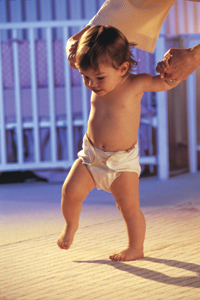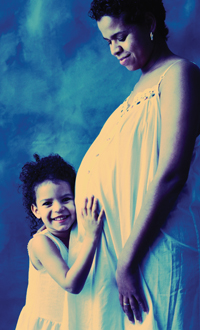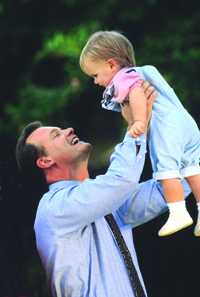
Features
Research
Infant Attachment
The structure of the human brain, even the sensory cortex, is unique
for each individual. This is so from conception through birth and the
entire lifespan. Even the early embryo has a style of imprinting
similar to attachment where, depending on the mother’s perception of
her world, the blood flow to the embryonic brain can be changed.
September 18, 2009 By Michael J. Shea PHD & Judith Suarez PHD
The structure of the human brain, even the sensory cortex, is unique for each individual. This is so from conception through birth and the entire lifespan. Even the early embryo has a style of imprinting similar to attachment where, depending on the mother’s perception of her world, the blood flow to the embryonic brain can be changed.
If the mother undergoes enough stress, more blood will flow to the brain stem for protection. In other words, the human brain depends on experience to activate and create pathways. When there is a lack of experience, neurons will prune themselves, which means they die. This is the “use-it-or-lose-it” principle.

|
|
|
|
Attachment theory describes an innate system in all infants. It motivates the infant to seek proximity to mothers and other mother figures (primary caregivers). Attachment also motivates the infant to establish communication with the mother person. This dramatically improves the chances of survival for the infant. Proximity equals protection. It is important to remember that the amygdala comes online first after birth and is exquisitely tuned to fear and danger. The quality and quantity of physical touch that the infant receives is crucial at this point.
The infant is attuning its nervous system to the mother’s cardiovascular rhythm and respiratory breathing just by skin-to-skin contact. There is even a part of the brain that specifically reads the quality of this touch for its context for love and affection.
The basic process of attachment is that the immature experience of the infant is filtered through the supposedly mature neurological system of the adult. A corollary to this principle is that the immature experience of the infant also acts as a filter for the mature or immature experience of the adult in the attachment relationship. Thus, attachment is a bi-directional co-metabolic system.
The interactions between the infant and the mother are collaborative, resonate and attuned. This means that words that are spoken, body movement, gestures and facial expressions are all congruent.
The right hemisphere of the infant recreates the mother person’s brain and body in its right hemisphere and has the capacity to metabolize the caregivers stress states as well as
the mother’s joy in the building of its brain. Likewise, the adult right hemisphere recreates the infant’s brain and body and metabolizes the stress states and joy of the infant.
This creates a resonate field for an interactional system that will be biased towards either joy or fear through the lifespan. If one didn’t get enough love during infancy, it’s never too late in the lifespan to overhaul your love quotient.
This literature has been studied since the 1940s and it is now felt that there are four types of attachment – one type of secure attachment and three types of insecure attachments.
In the secure attachment, the parent(s) forms a safe haven and a secure base for the infant. There is sensitivity to the infant’s signals and the parent is emotionally available.
The parent is able to perceive the infant’s needs and be effective at meeting those needs. This is a reflective relationship. In other words, the parent instinctively knows what to do and how to do it most of the time and if she is not able to do it, is capable of an interactive repair of the break in the attachment process.
The interactions between the infant and the mother are collaborative, resonate and attuned. This means words, body movement, gestures and facial expressions are all congruent. A natural rhythm of engaging, disengaging and then re-engaging is established to meet the infant’s pacing.
The expectation that the infant develops is that the world and others in it can meet my needs most of the time. By the time the orbitofrontal cortex comes online at 10 months post birth the infant and mother can sustain an eye gaze that creates a joyful resonance.
This joyful resonance creates the connections to the apex of the infant’s corticolimbic system necessary for the establishment of joy and the capacity to have executive control over ones emotions and affective states. The eye gaze of joy lasts approximately six seconds before
the infant averts its eye contact.
 |
|
|
|
Both the nervous systems of the mother and her infant resonate with excitement and an aroused state based on joy rather than stress.
In the secure attachment, for families not at risk this represents 55-65 per cent of the population.
The first type of insecure attachment is called avoidant. This style of attachment is one in which the parents adopt an emotionally distant stance from the infant and display neglectful and rejecting behaviors.
The parents are emotionally unavailable and relatively insensitive to the child’s state of mind.
Frequently, the parent does not hear or see requests for help and is ineffectual at helping the infant when its needs are perceived. Thus, there is a very low degree of affect attunement. This means that the words coming from the parent’s mouth
don’t match the facial expression.
The expectation of the infant is that attempts to connect with the world are useless. There is a decrease in the belief that such attempts will be successful. Therefore, the infant decreases its seeking of proximity to the care giver and increases not only its distance from others, but also to itself. The infant learns to dismiss and deactivate the outer surface of its soma but on the inside is quite active. This means that the infant lives in a state of fight/flight.
Because this becomes chronic, the autonomic nervous system uncouples itself and becomes nonreciprocal in its functioning. In other words, when the infant is sympathetically activated, the parasympathetic will not act to lower the sympathetic tone but rather will cause the infant to withdraw as a self-soothing behavior.
So on the surface, the infant has the appearance of being calm. But this parasympathetic state is actually a set up for dissociation.
In families not at risk, the avoidant attachment represents 20-30 per cent of the population.
The third type of attachment is called the ambivalent attachment. It is sometimes called resistant. In this style, parents are inconsistently available, inconsistently sensitive and perceptive and inconsistently effective in affect attunement with the infant.

|
|
|
|
The highlight of an ambivalent attachment is that the parent has moments of intrusion upon the infant that is invasive although it is not generally hostile. In other words, the infant may be quietly sleeping in its crib and, all of a sudden, the parent will grab it, toss it in the air and squeal with delight.
This means that the parent is involved in their own mental state and cannot see the child’s needs which in the example just sited is the need for sleep and rest. Therefore the infant’s life is one of unpredictability and uncertainty. The infant attempts to maximize its focus on the mother but the focus causes distress. The autonomic nervous system stays in a chronic alarm state, just below the threshold of fight/flight.
The expectation of the infant is that the world is willy-nilly. The world may intrude at any time and equally so the world will turn away and ignore the infant at any moment. Consequently there is an increase in the infant’s uncertainty and an increase in the need for comfort.
Unfortunately, there is a decrease in the sensory experience of comfort. This attachment style in families not at risk represents 5-15 per cent of the population.
The last type of insecure attachment is called the disorganized or disoriented. In this style, the parent expresses paradoxical communication.
These interactions may include parental behaviours that are fearful, disorienting or frightening to the child. The parental behaviour is the source of the fear and disorientation. This is seen in many families that do not display physical abuse. But in high risk households, up to 80 per cent of children form this attachment. Whereas in low risk households,
20-40 per cent form this attachment.
The expectation of the infant is that there is no safety in the environment. The infant must massively upregulate its parasympathetic nervous system, have its amygdala constantly being kindled and this results in freezing or dissociative behaviours.
This type of attachment increases the amount of aggression that the infant has towards itself and others. It is also a set up for more intense psychological problems, especially dissociation later in life.
Attachment sets up a lifelong set point in the nervous system for joy, intimacy and love in a secure attachment and chronic alarm, fight/flight and dissociation in the insecure attachment. It is through the quality of loving touch that these insecure attachments can be rehabilitated.
We find that the practice of biodynamic craniosacral therapy is an essential tool for this kind of work. The statistics regarding the number of people in our culture with insecure attachments is staggering.
Overcoming lifelong habits and early imprinting during the pre- and perinatal time of life is not easy but it can be done. The therapist must slow down, come into their heart and allow love and compassion to come through their hands.
Print this page